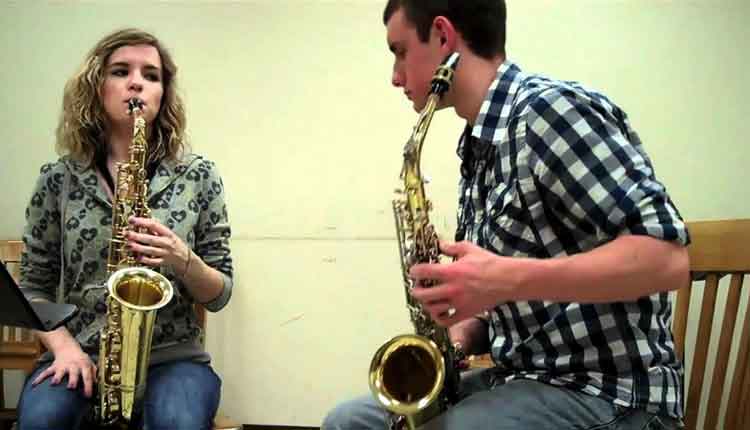| Problem | Cause | Solutions |
|---|---|---|
| Squeaking | Reed crooked | Adjust the tip of the reed to the tip of the mouthpiece. The reed should line up directly over the rails. |
| Chipped reed | Replace the reed. | |
| Bottom teeth on the Reed | Cover the bottom teeth with bottom lip. | |
| Top teeth not on mouthpiece | Instruct student to anchor the top teeth on the mouthpiece as if the weight of the head is on mouthpiece. | |
| Warped mouthpiece | Replace mouthpiece. It cannot be repaired. | |
| Too much mouthpiece into mouth | Gradually have the student put less mouthpiece into mouth until it stops squeaking. | |
| Not enough mouthpiece is in mouth | Usually, this is not the problem, but have the student put more mouthpiece until the squeaking stops. | |
| Warped reed (tip) | If the tip is warped, have the student wet the reed with saliva or water. Put the tip of the reed over the table(flat part) of the mouthpiece. Place the thumb over the tip of the reed and press down. Gently move the reed back and forth with very little distance. This does not need to be done for long. | |
| Warped reed (table) | Place the reed on a flat surface, such as a plate of glass. If the back of a the reed is flat against the surface, the reed is not warped. If the reed rises in the middle, the reed is warped. If the warp is very slight, place the flat side of the reed over a theyet of very fine sandpaper which is over the glass or a perfectly flat surface. Sand the reed down until the reed is no longer bowed. This will only be effective if the warp is very slight. If the student has to sand the reed down too much, it will take out too much of the heart of the reed and the sound will not be full. If the bow is deep, throw the reed away. It will never blow easily. | |
| Puffing out cheeks | Tell them not to puff out cheeks. Sometimes that works. If not, tell them to play a note. As they sustain the note, tell them over and over to bring in cheeks. Usually by the end of the student’s breath, they will bring in their cheeks. Tell the student to suck the air out of the mouthpiece. The shape of the lips and the shape of the muscles are the same as needed to blow air into the mouthpiece without puffing out cheeks. The saxophone embouchure is more relaxed that the clarinet embouchure, but still firm enough to keep cheeks from puffing. | |
| Unfocused Sound | Too much mouthpiece | Have the student put less and less mouthpiece into the their mouth until the sound improves. |
| Depressing side keys | Students often putheys the side keys of the saxophone down without realizing it. Show the student where they are touching the side keys with the inside or palm of their hands. The student must arch the their hand around the saxophone in order to not strike keys unintentionally. | |
| Puffing out cheeks | See #10 in Squeaks | |
| Top teeth on mouthpiece | Students at the beginning level must keep top teeth on the mouthpiece. Though some college professors and professionals use different embouchures for different reasons, at this level the basic fundamentals are essential. | |
| Blowing too hard | Tell them not to blow with their entire strength. Playing the saxophone is natural. It would not be natural to scream all day long, so it would not be natural nor wise to scream through a musical instrument all day long. | |
| Thin Sound | Too little mouthpiece | Have the student put a little more in at a time until the sound is full. |
| Weak reed | Never start anyone with a 1 1/2 strength reed. Start beginners with a strength 2 reed and move to 2 1/2 as soon as the student is ready. You do not have to be as quick to move a student to a strength 3. When the sound become thin on a new 2 1/2 reed, it is time to try the next strongest reed. | |
| Too hard a reed | Use a softer reed. | |
| Pinching the mouthpiece | Tell the student to relax. Only put enough pressure on the reed to seal the air from coming at the sides of the student’s mouth. You may need to add a little more mouthpiece into the students mouth. Again, do this in small steps at a time. | |
| Not enough air | Students should not blow air out with all their might. The student needs to push the air out with enough force to fill the saxophone. | |
| Posture | Sit on the edge of the chair. Back straight, both feet flat on the floor. The neck should be straight and not hanging the head down. Adjust the strap so this is not a problem. (You will be surprised how many students will never think to shorten the strap to make the saxophone easier to play.) | |
This article sponsored by Northeastern Music Publications, Inc.


